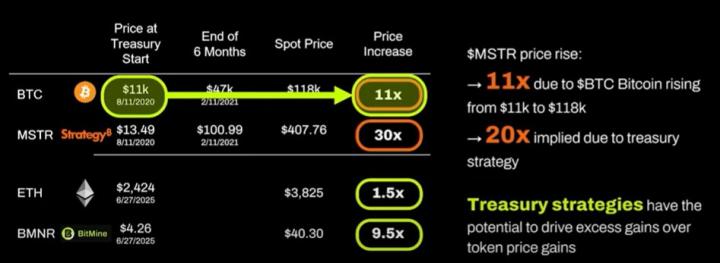Source: Pantera; Compiled by: AIMan@Jinse Finance
Recently, BitMine Chairman Tom Lee and Pantera Capital partner Cosmo Jiang discussed the reasons for investing in Digital Asset Treasury (DAT) companies, exploring the motivations behind DAT and explaining why DAT might be a better crypto investment tool than holding ETFs or underlying tokens. They discussed the driving factors for DAT emergence, why BitMine chose Ethereum Treasury, potential DAT risks, and more. Here are the highlights of their conversation:
Cosmo: What is the current market setup and structure? What truly drives the rise of digital assets?
Tom Lee: Looking ahead to 2025, market leaders will come from two areas. One is still AI, MAG 7, and similar complexes, but this year, crypto-related stocks will also become another market leader...
I believe the AI boom is actually an enablement, as it clearly shows investors that the digital economy is emerging. I think this sparks imagination, and now investors are very interested in programmable currency. I believe stablecoins can be the ChatGPT story of the crypto world precisely because we have seen mainstream adoption by consumers, merchants, and banks.
Cosmo: What kind of investor group is seeking investment opportunities in digital asset treasury companies?
Tom Lee: Institutional and retail investors' interest in digital assets is remarkable. On the institutional investor side, I think not only Circle, but also MicroStrategy, because MicroStrategy indeed changed the nature of the convertible bond and bond markets. The bonds they issued - including senior notes, convertible bonds, and bonds - have always been the best-performing in their class. If you didn't hold MicroStrategy bonds, your performance would always lag behind those market indices...
I was as surprised as you. I thought, "When the ETF comes, do you really need MicroStrategy? Because you can buy Bitcoin at net asset value (NAV), and as long as you deduct a small fee, it will always be Bitcoin." It turns out that these digital asset treasury companies, and those companies that do it right, can indeed increase your crypto holdings per share. This has a significant advantage over directly holding ETFs. Because both will rise with price, but one will give you additional crypto units each year.
Cosmo: People think digital asset treasuries are just high-leverage crypto investments, but the reality is much more nuanced. How do you analyze the main driving factors of digital asset treasury company performance?
Tom Lee: I believe crypto treasury companies have five advantages, ultimately boiling down to a sixth factor: management. But the primary driver is capital markets. If a crypto treasury company trades at a premium, say, twice the premium. This means every time they issue stock, they can buy two units for each unit sold after issuance, because that's the premium. They are actually increasing your holdings by selling stocks, which is a very strange concept, but it is indeed a value-add.
The second driving factor is that ETF holders bear funding costs. Suppose you go to an institution to borrow money at a 10% interest rate. First, crypto ETF holders are companies, so their borrowing costs are lower than most individual investors. Second, crypto treasury companies can use crypto volatility to reduce funding costs through convertible bonds, derivatives, or even bond markets. So they can actually borrow money at almost zero interest rates, and MicroStrategy's borrowing rate is 0%.
The third advantage is that listed companies can actually issue stocks. Imagine another digital asset treasury company - suppose there are one or two companies holding Ethereum, but one trades at net asset value (NAV). The company making a premium acquisition can acquire the other company at net asset value, and suddenly the ETH holdings per share will increase.
Another difference is that they can establish an operating company to increase holdings per share. For example, within Ethereum, this Ethereum treasury company can actually participate in the Ethereum ecosystem, accumulating more ETH and ultimately generating returns.
But ultimately, it depends on whether the market believes the story. So I think it's crucial that the current management team has a clear vision of how to achieve all the goals I just described. I believe tokens that the market believes in will trade at a considerable price. That's why Metaplanets trades at a seven-fold premium. And I think, especially in emerging token areas, these tokens can actually maintain a five to seven-fold premium long-term.
Cosmo: Yes, I think the last two points you mentioned - the ability to generate revenue and participate in ecosystem development - are unique to non-Bitcoin treasury companies.
Cosmo: You once made an interesting analogy with another industry where valuation was based on reserves, but trading prices were higher than reserve value. What was that situation? Why?
Tom Lee: There are some precedents, and I think the most easily recalled might be the oil or commodity industry...
In 1990, the largest market cap stock was ExxonMobil, which was in the top five of the S&P 500 for 25 years. So throughout your entire career, you might say, "Well, the largest stock in the market is ExxonMobil." Interestingly, it never traded on profitability, only on proven reserves, and its trading price was always higher than proven reserves. Because investors would say, "Hey, this is ExxonMobil. They're smart, they'll drill, they'll always find more oil." So you would always value it at a premium above its underlying oil holdings.
Cosmo: Not all digital asset treasuries are created equal. In your view, what qualities and characteristics should a good DAT possess?
Tom Lee: For investors or equity investors, two things are truly important. First, the company's operations have intrinsic value; second, they believe the company's profitability can exceed capital costs, so they will reward the company...
Second, you must find truly reliable leading investors. The challenge for digital asset treasury companies is that you must demonstrate trust in the crypto world, so they will collaborate with you, and trust in traditional finance, or Wall Street. I think for many digital asset treasury companies, finding this will be very difficult...
Cosmo: I've probably seen about 70 projects, and 60 projects were successful. I completely agree with your point. The team is one of the most important factors. Obviously, you need a capital markets engine, you need a good marketing engine.
Cosmo: BitMine is an Ethereum treasury company. Why choose Ethereum?
Tom Lee: For us, Ethereum seemed to be the ideal starting point for creating a digital asset treasury company. Ethereum truly caught our attention because we realized it is where real-world assets are tokenized and placed on the blockchain. Most real-world assets exist in this situation. Stablecoins are a good example. Stablecoins, the source of Circle's potential IPO, essentially put dollars on the blockchain, and then you can use them for crypto trading...
Now banks are actually interested in this. So JPMorgan will create its own stablecoin, and Goldman Sachs will too. JPMorgan will use Ethereum. Robinhood just announced some tokenization plans to tokenize some private assets. But again, many of these will ultimately be conducted on the Ethereum blockchain.
Imagine Ethereum as software, some say it's like oil, but in reality, it's software that drives all these activities. If you observe the tech stack, usually when you reach that level, you typically get the highest multiples. Therefore, I believe Ethereum might be severely undervalued relative to Circle. Of course, we think the demand for stablecoins could actually grow 10-fold. Treasury Secretary Besen believes it could be a $20 trillion market. From today's over $200 billion, this means 10-fold growth. This is exponential. This will bring exponential demand for Ethereum.
Cosmo: What risks do you think exist, or what should we consider that we might be overlooking?
Tom Lee: Risks certainly exist, but interestingly, some might argue that from certain perspectives, the risks of digital asset treasury companies might be smaller than ETFs.
I think the first risk they both face is the so-called "Crypto Winter", where prices will go through a cycle, reach a peak, and then prices will drop. For ETFs, the amount of cryptocurrency you hold is fixed, such as per share of Ethereum. So if Ethereum's price drops, your losses will increase accordingly. But during your ETH treasury holding, that entity might have doubled or even ten-folded your Ethereum holdings.
Suppose a digital asset treasury company owns Ethereum worth $4, but two years later, their Ethereum per share is worth $20, or $30. If Ethereum enters a bear market and drops 40%, your stock price won't actually drop because the ETH you own per share has significantly increased in value. I think this is one risk, but the value of ETH per share can grow, so the risk can be mitigated.
Second, if capital markets become unfriendly, financing becomes very difficult. So the five or six engines I mentioned before now become only one or two ways to increase net asset value per share, and the price-to-earnings ratio might also decline. I think this is possible. But again, because it's a publicly traded stock, this will truly inspire the desire for integration, thereby creating scarcity again, and the premium might be restored. I think there are methods, and there are risks, but these risks also have offsetting measures.
Cosmo: Risks exist, certainly volatility......
But I basically agree with your point that there are many offsetting factors. One thing people like to bring up is its relationship with Grayscale, right? I think Grayscale's Bitcoin trading ultimately traded for a long time at a price below net asset value (NAV). That was a very different situation. In fact, Grayscale is a closed-end trust. Digital asset treasury companies are not closed-end investment vehicles, but listed companies. So, when they ultimately integrate, they can do buybacks, they can acquire any such transaction at half the asset net value.
Tom Lee: Actually, Cosmo's point makes sense. It's not that any digital asset treasury wants to do this, but if their trading price is below net asset value, theoretically they would sell digital assets and buy back stocks, because this is what an efficient market would expect. Or, for the same reason, this could also be a reason to drive two companies to merge.







